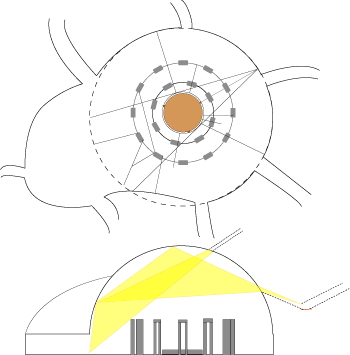The Hall Of Star
Great chamber of wonders deep underground
 Deep underground in the Dwarven kingdom of Ghrad Yg Thrakl lies the wonder of engineering and testament to the craft of the Dwarves that is the Hall of Star.
Deep underground in the Dwarven kingdom of Ghrad Yg Thrakl lies the wonder of engineering and testament to the craft of the Dwarves that is the Hall of Star.
The Hall serves two main purposes: as an astronomical device and as a huge soundbox for concerts.
The Calendar of Stone and Light
Dwarves have always been amazed at the beauty of the world and the universe at large. However unlike the elves who as part-fey are drawn to quickly growing things like forests and its denizens, the part-titan blood of the Dwarves pulls them towards the nature that changes only slowly: mountains, planets and stars.
Long before the Dwarves started building their great underground kingdoms they already built great astronomical devices from stones carried hundreds of miles. Stone circles still stand all over the world and for the most can still accurately predict the coming of spring, the greater tides and anything else they were designed for.
Dwarves are reluctant to give up knowledge and one of their regrets after moving underground was the loss of astronomy. Therefor in Ghrad Yg Thrakl they built the Hall of Star, a huge and precisely carved cavern where with a system of long straight shafts, mirrors and great lenses they project the outside sky onto the surface of a hemispherical dome surrounding a double stone circle. The drawing to the side here is a simplification of the system, as in fact every point on the dome is created by the overlap of at least three or four projected images (which creates a blurry image if you look at it closely, but they are working on this).
The Hall of Star can accurately give the time of day as well as the day of the year, predict high tides for the nearby freestate, predict eclipses and be quite pleasing to look at.
The Concert Hall
Elves sometimes deride Dwarves for a disregard for life, but this is a false perception because Dwarves have in fact a great respect for life. Their definition of Life, however, extends further than that of the elves and they see the World itself and the rock it's made from as alive (and not just the petrified trolls either).
The Hall of Star then acts as a sound box, or rather as part of one. In fact the entire underground kingdom of Ghrad Yg Thrakl is one big musical instrument with corridors and halls carved with regard of the flows of air and sound. The goal of all this is to amplify what Dwarves call the Heartbeat of the Mountain.
Central to the Hall of Star is a big gong, hung horizontally and several yards across, which is rang by dropping a big cloth-covered ball of stone onto it from the ceiling (the mechanism then immediately pulls it up again). To the astronomically least interesting side there's a big stage area occupied during performances by drummers, hornblowers and a choir.
During a recital Dwarven musicians will interweave their music with the heartbeat of the mountain while highly athletic sound engineers run around the kingdom to open and close doors, modifying the sound as they do so.
Around the outside of the Hall of Star is a carpeted audience area designed so that sounds made there have only a limited impact on the music.










Comments
However, we have quite nice planetariums with hemispherical cinema screens, which can display many kinds of astronomical phenomena in pretty much full "night sky" quality.
Making an entire mountain range into a musical instrument... Could be done. In principle. If the mountain range is geologically stable. And if you can get sufficiently precise readings on the properties of the rock in different parts of it. But I'm not sure that you could survive being inside it when it's played. Also, the amount of explosives required to carve out the rock in a realistic time-frame would be enough to give even a nuclear power pause for thought...
- Jake
Musical instrument mountain: I don't think you can use explosives for that. To much inprecise.
Add your own comment: